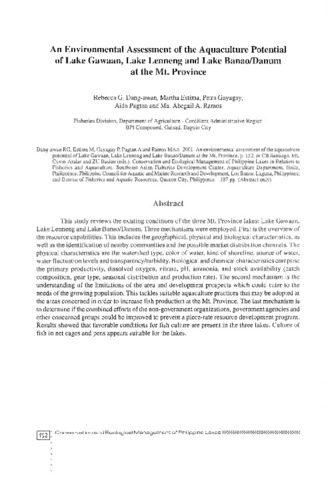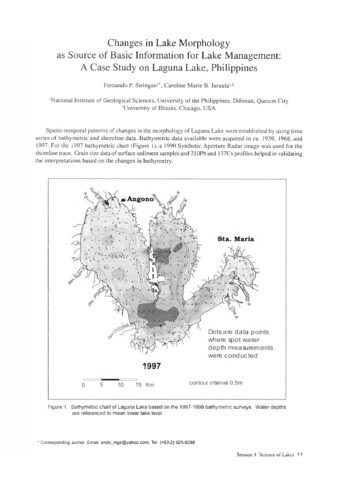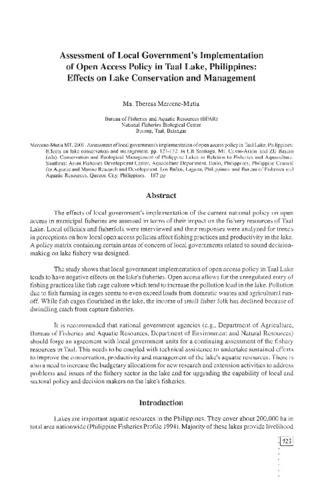Five thousand years of environmental history: Paoay Lake, northern Luzon, Philippines
| dc.contributor.author | Stevenson, Janelle | |
| dc.contributor.author | Finn, Jan | |
| dc.contributor.author | Siringan, Fernando P. | |
| dc.contributor.author | Madulid, Domingo | |
| dc.contributor.editor | Cuvin-Aralar, Maria Lourdes | |
| dc.contributor.editor | Punongbayan, Raymundo S. | |
| dc.contributor.editor | Santos-Borja, Adelina | |
| dc.contributor.editor | Castillo, Lourdes V. | |
| dc.contributor.editor | Manalili, Eduardo V. | |
| dc.contributor.editor | Mendoza, Marlynn M. | |
| dc.date.accessioned | 2021-07-27T02:54:11Z | |
| dc.date.available | 2021-07-27T02:54:11Z | |
| dc.date.issued | 2005 | |
| dc.identifier.citation | Stevenson, J., Finn, J., Siringan, F. P., & Madulid, D. (2005). Five thousand years of environmental history: Paoay Lake, northern Luzon, Philippines. In M. L. Cuvin-Aralar, R. S. Punongbayan, A. Santos-Borja, L. V. Castillo, E. V. Manalili, & M. M. Mendoza (Eds.), Proceedings of the First National Congress on Philippine Lakes (pp. 13-19). Southeast Asian Regional Center for Graduate Study and Research in Agriculture (SEARCA). | en |
| dc.identifier.issn | 1656-8099 | |
| dc.identifier.uri | http://hdl.handle.net/10862/6113 | |
| dc.description.abstract | The environmental history of Paoay Lake and its surrounding landscape is being examined through the analysis of pollen, diatoms, charcoal, mineral magnetics, and AMS dating. The project is part of a larger program of archeological research that examines the theory indicating an expansion of Neolithic people taking place out of Taiwan and into island southeast Asia around 4,000 years ago. The primary intention of the lake study is to determine if there is evidence of land clearance and agricultural development in the region during the late Holocene. Sediment cores collected from two different locations contain the last 6,000 years of environmental history at Lake Paoay. Pollen analysis shows that coniferous forest, dominated by Pinus, was prevalent in the landscape surrounding the site until around 5,000 years ago when the pollen signature changes to that more indicative of an open landscape (primarily grass). Charcoal as an indicator of fire is abundant throughout record, although the highest levels appear to occur around the time of forest decline. This corresponds well with a similar shift in vegetation at 5,000 years ago from the only other pollen core in the Philippines, Laguna de Bay. | en |
| dc.language.iso | en | en |
| dc.publisher | Southeast Asian Regional Center for Graduate Study and Research in Agriculture (SEARCA) | en |
| dc.subject | Paoay Lake | en |
| dc.subject | charcoal | en |
| dc.subject | Pinus | en |
| dc.subject | rice | en |
| dc.subject | Neolithic | en |
| dc.title | Five thousand years of environmental history: Paoay Lake, northern Luzon, Philippines | en |
| dc.type | Conference paper | en |
| dc.citation.spage | 13 | en |
| dc.citation.epage | 19 | en |
| dc.citation.conferenceTitle | Proceedings of the First National Congress on Philippine Lakes | en |
| dc.subject.asfa | lakes | en |
| dc.subject.asfa | pollen | en |
| dc.subject.asfa | Holocene | en |
| dc.subject.asfa | Bacillariophyceae | en |
| dc.subject.asfa | palaeoenvironments | en |
| dc.subject.asfa | fossil spores | en |
| dc.subject.asfa | progradation | en |
| dc.subject.asfa | coring | en |
| dc.subject.asfa | sediment | en |
Files in this item
| Files | Size | Format | View |
|---|---|---|---|
|
There are no files associated with this item. |
|||
This item appears in the following Collection(s)
-
LakeCon2003 [49]
Proceedings of the First National Congress on Philippine Lakes



